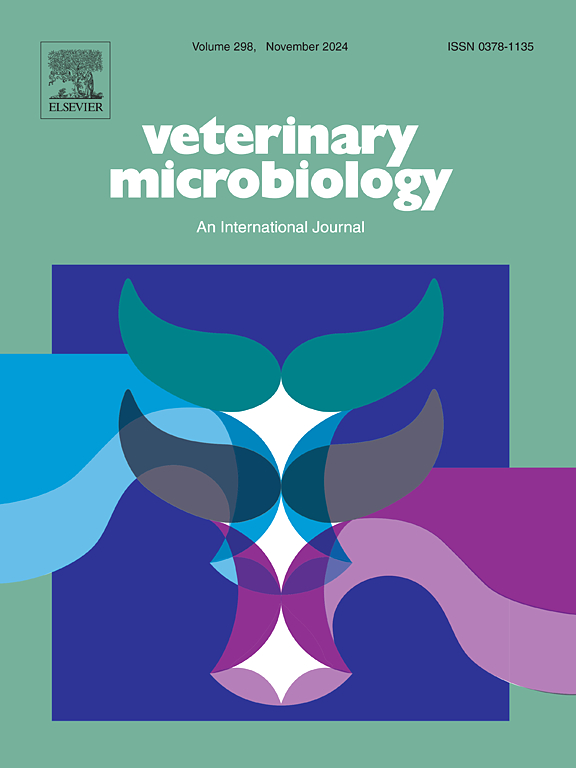利用二维凝胶电泳和免疫蛋白组学技术鉴定副猪青杆菌交叉保护的候选疫苗抗原
IF 2.4
2区 农林科学
Q3 MICROBIOLOGY
引用次数: 0
摘要
猪感染副猪绿脓杆菌可引起多浆液炎、关节炎和脑膜炎。在这15种血清型之间和体内存在一系列有毒到无毒的毒株。这就给生产具有广泛保护性的副猪弧菌疫苗带来了困难。亚单位疫苗在预防细菌性病原体方面具有重要意义,因为疫苗中的单个蛋白质高度保守且广泛存在。为了鉴定具有异源保护作用的副猪弓形虫新型亚单位疫苗候选物,用12939保护(HS069细菌素)或非保护(长崎细菌素)疫苗接种猪的血清,利用二维凝胶电泳和免疫印迹技术区分抗体反应。用质谱法鉴定了HS069或长崎疫苗接种动物血清中具有不同表达的蛋白。13种独特的蛋白与保护性免疫反应相关,其中4种蛋白在猪攻毒模型(ApbE, LpoA, YaeT和LppA)中以两种组合对抗副猪G.。这四种蛋白均具有免疫原性,可刺激猪体内的高抗体滴度。虽然ApbE、LpoA和YaeT的蛋白组合不能提高生存率,但LpoA、YaeT和LppA的组合可以提高生存率,这表明LppA对保护很重要。这项工作确定了一组蛋白质能够提高猪与副猪螺旋体挑战的存活率。此外,这项工作强调了一种利用保护性免疫反应识别候选疫苗抗原的新颖有效的方法。本文章由计算机程序翻译,如有差异,请以英文原文为准。
Identification of candidate vaccine antigens using 2-D gel electrophoresis and immunoproteomics for cross protection against Glaesserella parasuis
Glaesserella parasuis infection in swine causes polyserositis, arthritis, and meningitis. A range of virulent to nonvirulent strains exists between and within the 15 serovars. This has created difficulty in generating broadly protective vaccines against G. parasuis. Subunit vaccines are of interest in protection against bacterial pathogens, where the individual proteins within the vaccine are highly conserved and widely present. To identify novel subunit vaccine candidates for heterologous protection against G. parasuis, previously generated serum from bacterin vaccinated pigs that were protected (HS069 bacterin) or non-protected (Nagasaki bacterin) against heterologous challenge with 12939 was used to differentiate the antibody response using 2-D gel electrophoresis and immunoblotting. Proteins with differential representation between blots probed with serum from HS069 or Nagasaki bacterin vaccinated animals were identified by mass spectrometry. Thirteen unique proteins were associated with the protective immune response and four of these proteins were tested in two combinations against G. parasuis in a swine challenge model (ApbE, LpoA, YaeT, and LppA). All four proteins were immunogenic and stimulated high antibody titers in pigs. While the protein combination of ApbE, LpoA, and YaeT did not provide improved survival, the combination of LpoA, YaeT, and LppA did, suggesting LppA is important for protection. This work identified a group of proteins capable of improving survival in pigs challenged with G. parasuis. Additionally, this work highlights a novel and effective method to identify candidate vaccine antigens utilizing the protective immune response.
求助全文
通过发布文献求助,成功后即可免费获取论文全文。
去求助
来源期刊

Veterinary microbiology
农林科学-兽医学
CiteScore
5.90
自引率
6.10%
发文量
221
审稿时长
52 days
期刊介绍:
Veterinary Microbiology is concerned with microbial (bacterial, fungal, viral) diseases of domesticated vertebrate animals (livestock, companion animals, fur-bearing animals, game, poultry, fish) that supply food, other useful products or companionship. In addition, Microbial diseases of wild animals living in captivity, or as members of the feral fauna will also be considered if the infections are of interest because of their interrelation with humans (zoonoses) and/or domestic animals. Studies of antimicrobial resistance are also included, provided that the results represent a substantial advance in knowledge. Authors are strongly encouraged to read - prior to submission - the Editorials (''Scope or cope'' and ''Scope or cope II'') published previously in the journal. The Editors reserve the right to suggest submission to another journal for those papers which they feel would be more appropriate for consideration by that journal.
Original research papers of high quality and novelty on aspects of control, host response, molecular biology, pathogenesis, prevention, and treatment of microbial diseases of animals are published. Papers dealing primarily with immunology, epidemiology, molecular biology and antiviral or microbial agents will only be considered if they demonstrate a clear impact on a disease. Papers focusing solely on diagnostic techniques (such as another PCR protocol or ELISA) will not be published - focus should be on a microorganism and not on a particular technique. Papers only reporting microbial sequences, transcriptomics data, or proteomics data will not be considered unless the results represent a substantial advance in knowledge.
Drug trial papers will be considered if they have general application or significance. Papers on the identification of microorganisms will also be considered, but detailed taxonomic studies do not fall within the scope of the journal. Case reports will not be published, unless they have general application or contain novel aspects. Papers of geographically limited interest, which repeat what had been established elsewhere will not be considered. The readership of the journal is global.
 求助内容:
求助内容: 应助结果提醒方式:
应助结果提醒方式:


